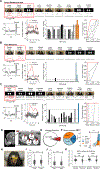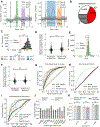Cross-modal representation of identity in the primate hippocampus
- PMID: 37883535
- PMCID: PMC11086670
- DOI: 10.1126/science.adf0460
Cross-modal representation of identity in the primate hippocampus
Abstract
Faces and voices are the dominant social signals used to recognize individuals among primates. Yet, it is not known how these signals are integrated into a cross-modal representation of individual identity in the primate brain. We discovered that, although single neurons in the marmoset hippocampus exhibited selective responses when presented with the face or voice of a specific individual, a parallel mechanism for representing the cross-modal identities for multiple individuals was evident within single neurons and at the population level. Manifold projections likewise showed the separability of individuals as well as clustering for others' families, which suggests that multiple learned social categories are encoded as related dimensions of identity in the hippocampus. Neural representations of identity in the hippocampus are thus both modality independent and reflect the primate social network.
Conflict of interest statement
The authors declare no competing interests.
Figures




References
-
- Seyfarth RM, Cheney DL, “Knowledge of Social Relations” in The Evolution of Primate Societies, Mitani J, Call J, Kappeler PM, Palombit R, Silk JB, Eds. (University of Chicago Press, Chicago, IL, 2012), pp. 629–642.
-
- Belin P, Bodin C, Aglieri V, A “voice patch” system in the primate brain for processing vocal information? Hear. Res. 366, 65–74 (2018). - PubMed
-
- Sliwa J, Planté A, Duhamel J-R, Wirth S, Independent Neuronal Representation of Facial and Vocal Identity in the Monkey Hippocampus and Inferotemporal Cortex. Cereb. Cortex. 26, 950–966 (2016). - PubMed
MeSH terms
Grants and funding
LinkOut - more resources
Full Text Sources

